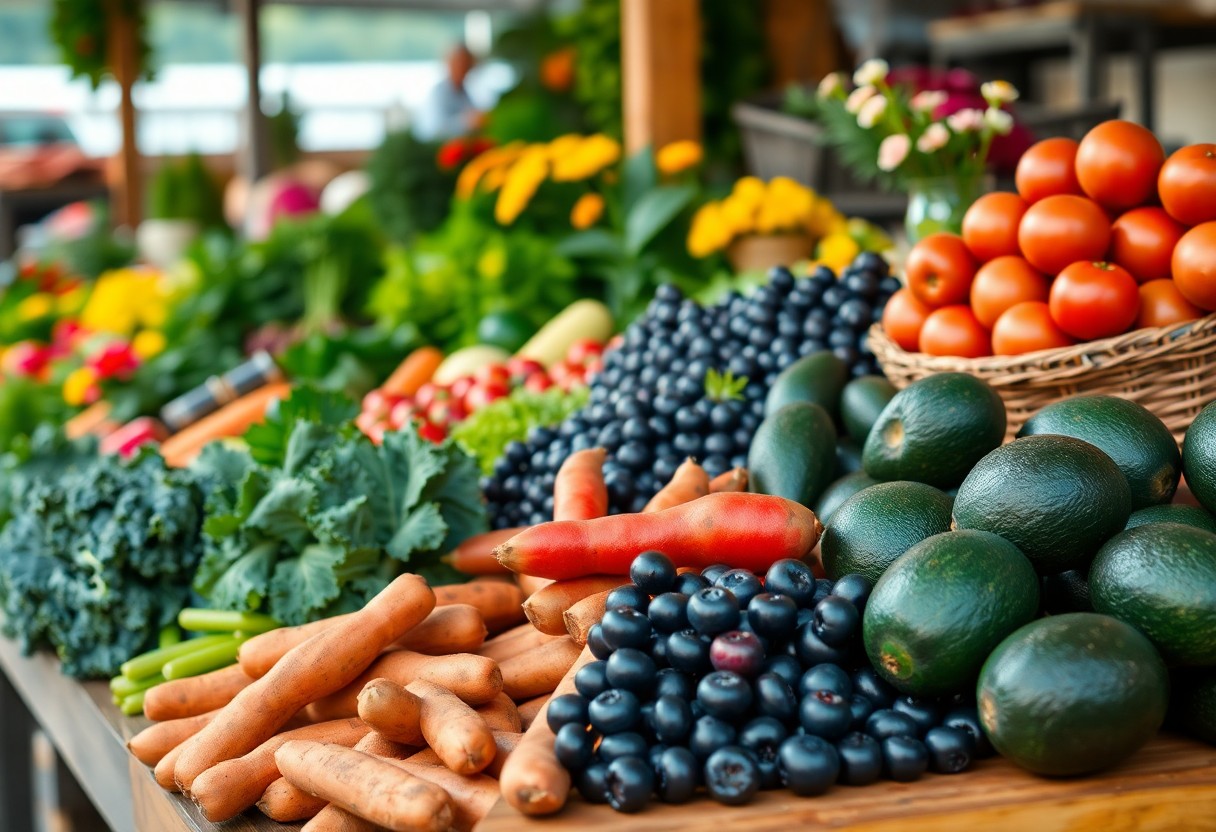Superfoods For Every Season – Eat Fresh Year-Round
- Home
- Uncategorized
- Superfoods For Every Season – Eat Fresh Year-Round
You can transform your health by incorporating seasonal superfoods into your diet, ensuring that you benefit from the richest nutrients available throughout the year. Each season brings its own bountiful harvest, offering a variety of fresh fruits and vegetables packed with necessary vitamins and minerals. By eating in harmony with nature’s cycles, not only do you enhance your nutrition but also support local agriculture and reduce your carbon footprint. Discover how to make the most of these vibrant, wholesome foods to elevate your meals and overall well-being.
Key Takeaways:
- Seasonal Variety: Consuming superfoods that are in season ensures maximum freshness and nutritional value throughout the year.
- Local Produce: Sourcing superfoods locally not only supports farmers but also reduces the carbon footprint, benefitting both health and the environment.
- Balanced Nutrition: Incorporating a diverse range of seasonal superfoods can provide a wider array of vitamins, minerals, and antioxidants crucial for overall wellbeing.

Spring Superfoods
As the days grow warmer and flowers begin to bloom, it’s time to embrace the vibrant array of spring superfoods that can nourish your body and uplift your mood. Spring is the perfect season to invigorate your meals with fresh ingredients that are not only delicious but also packed with nutrients to support your health. From leafy greens to juicy berries, you’ll find plenty of options to keep your diet fresh and exciting throughout the season.
Leafy Greens
About leafy greens—these nutrient-dense vegetables, such as spinach, kale, and arugula, are abundant in spring. They are loaded with vitamins A, C, and K, along with minerals like iron and calcium. Incorporating leafy greens into your meals can boost your energy levels and improve your overall health, providing a refreshing base for salads, smoothies, and cooked dishes.
Berries
Around spring, berries like strawberries, blueberries, and raspberries flourish, offering you an excellent opportunity to indulge in their natural sweetness. These fruits are not only delicious but also high in antioxidants, which help combat oxidative stress in your body. Berries are incredibly versatile and can be enjoyed in various ways, from snacking to toppings on yogurt or blended into smoothies.
And while all berries are tasty, it’s important to note that they also boast impressive health benefits. Strawberries, for example, are rich in vitamin C, which can enhance your immune system, while blueberries have been linked to improved cognitive function. Perhaps best of all, berries are low in calories and high in fiber, making them an ideal snack for weight management. Including these superfoods in your diet can boost your mood and keep you feeling revitalized as the weather warms up.
Summer Superfoods
The summer season is a time to indulge in vibrant, fresh flavors straight from the garden. Enjoying seasonal produce like juicy berries, refreshing melons, and nutrient-packed greens will not only elevate your meals but also give your body the nourishment it needs to thrive in the heat. Embrace these summer superfoods to boost your energy, enhance your mood, and keep you feeling light and refreshed all season long.
Stone Fruits
Along with the warm sunshine, summer brings a delightful array of stone fruits such as peaches, cherries, and plums. These juicy fruits are rich in vitamins A and C, and they offer a sweet burst of flavor with every bite. Enjoy them fresh, in smoothies, or grilled for a unique twist. Incorporating these fruits into your diet can help you stay hydrated and provide vital nutrients that support your overall health.
Zucchini and Squash
Above ground, zucchini and squash shine as some of summer’s most versatile vegetables. They are low in calories yet packed with vitamins and minerals, making them the perfect addition to salads, stir-fries, or even baked dishes. Their mild flavor allows them to absorb spices and sauces beautifully, making it easy to incorporate them into your meals.
Due to their high water content, zucchini and squash help keep you hydrated during the hot summer months. Moreover, they are excellent sources of fiber, which can aid in digestion and promote a sense of fullness. These vegetables also contain antioxidants that may contribute to improved heart health and inflammation reduction. Enjoy zucchini and squash in various recipes, from zoodles to ratatouille, as they bring not only flavor but also a wealth of health benefits to your plate.
Fall Superfoods
Your journey into fall superfoods unveils a treasure trove of nutritious options that nourish your body and delight your senses. The cooler temperatures signal a shift in seasonal produce, bringing with it vibrant flavors and health benefits that fulfill your cravings while supporting your well-being.
Pumpkins and Squash
Across the vibrant autumn landscape, pumpkins and various squashes emerge as star players in your kitchen. Rich in vitamins A and C, they not only boost immunity but also promote healthy skin. Their robust flavor allows you to explore creative recipes, whether in soups, pies, or roasted dishes, making these vegetables a versatile choice for fall meals.
Apples and Pears
Across orchards and markets, apples and pears come into season, offering a sweet and satisfying addition to your fall diet. These fruits are packed with fiber and antioxidants, supporting heart health while helping you manage weight. Their crisp textures and delightful flavors make them perfect for snacking, baking, or adding to salads.
Considering the nutritional profiles of apples and pears, they provide noteworthy health boosts. Apples contain high levels of quercetin, which may help reduce inflammation, while pears are an excellent source of vitamin C. Both fruits can aid digestion with their fiber content, making them crucial staples for your fall meals. Embrace these seasonal delights and enjoy their natural sweetness while reaping the many health benefits they offer.
Winter Superfoods
To maintain a healthy diet during the winter, you should embrace an array of superfoods that are abundant in vitamins and minerals. Discover the benefits of these winter delights in this guide, and for more insights, check out 11 Top Fall Superfoods to Add to Your Diet This Season.
Citrus Fruits
Among the best winter superfoods, citrus fruits like oranges, grapefruits, and lemons stand out with their high vitamin C content. This important nutrient helps boost your immune system, keeps your skin glowing, and contributes to overall health during the cold months. Incorporating these vibrant fruits into your diet can add flavor and a plethora of health benefits.
Root Vegetables
Root vegetables, including carrots, sweet potatoes, and beets, are nutritional powerhouses that thrive in winter’s chilly conditions. These versatile veggies are packed with vital nutrients such as fiber, vitamins, and minerals, making them perfect for hearty meals. You can roast, mash, or even pickle them for added variety.
Hence, incorporating root vegetables into your winter diet not only enhances your meals but also supports your well-being. They provide a good source of fiber, which aids in digestion and helps maintain steady energy levels. Rich in antioxidants, root vegetables like beets can reduce inflammation and combat oxidative stress in your body. Make sure to consume a variety of these nutrient-dense options to reap the maximum health benefits while enjoying the delicious flavors they offer.
Tips for Eating Seasonally
Keep your meals fresh and vibrant by following these tips for eating seasonally:
- Shop at local farmer’s markets to find what’s ripe and in season.
- Join a CSA (Community Supported Agriculture) for regular deliveries of seasonal produce.
- Plan your meals around seasonal ingredients to maximize flavor and nutrition.
- Experiment with new recipes that highlight the produce of each season.
This approach can help you enjoy a diverse and exciting diet throughout the year.
Finding Local Markets
With the rise of interest in locally sourced food, finding farmers’ markets in your area is easier than ever. Utilize online directories or community bulletins to discover the markets that offer fresh, seasonal produce. Establishing a routine visit to these markets is beneficial not only for your health but also for supporting local farmers and fostering community ties.
Meal Planning with Seasonal Ingredients
Seasonal ingredients offer an opportunity to eat fresh and diverse meals throughout the year. By incorporating produce that’s in season, you not only enhance the flavor of your dishes but also ensure that you’re consuming nutrient-rich foods at their peak.
Planning your meals around seasonal ingredients can dramatically elevate your culinary experience. Start by checking what fruits and vegetables are currently in season in your area—this will allow you to create a weekly menu that highlights their freshest flavors. Be sure to explore various cooking methods to maximize taste and retain the nutrients that may be lost through overcooking. Always keep an eye out for special deals at your local market, as seasonal ingredients are often more affordable than their out-of-season counterparts. By doing this, not only will your meals be healthier, but your overall food budget may also decrease.
Nutritional Benefits of Seasonal Eating
For optimal health, you should prioritize seasonal eating, as it offers maximum flavor and nutritional value. Foods that are in season are often fresher and more nutrient-dense, providing vital vitamins and minerals your body craves. Additionally, these foods tend to be locally sourced, reducing your carbon footprint and supporting the community. By eating with the seasons, you can enhance your overall well-being and discover a variety of flavors that keep your meals exciting and satisfying. This approach promotes a balanced diet while aligning with nature’s rhythms.
Conclusion
Hence, embracing superfoods throughout the seasons allows you to optimize your diet and enhance your overall health. By incorporating fresh, seasonal produce into your meals, you not only enjoy peak flavor but also harness the nutritional benefits that these foods offer. This approach encourages a balanced diet that adapts to your body’s needs year-round, promoting vitality and well-being. So, make it a habit to explore the superfoods available in each season and elevate your culinary experience while nourishing your body.
Q: What are superfoods and why are they important for seasonal eating?
A: Superfoods are nutrient-dense foods that provide a variety of health benefits, often packed with vitamins, minerals, and antioxidants. Eating superfoods according to the season ensures that you are consuming the freshest and most flavorful produce available. This not only enhances the taste of your meals but also increases your nutrient intake, as seasonal foods are typically harvested at their peak ripeness. Seasonal eating also supports local farmers, reduces the carbon footprint associated with transporting out-of-season foods, and encourages a diverse diet throughout the year.
Q: How can I incorporate superfoods into my diet throughout the different seasons?
A: Incorporating superfoods seasonally can be achieved by exploring local farmer’s markets or grocery stores that emphasize seasonal produce. In spring, consider adding asparagus and strawberries; summer offers berries, tomatoes, and leafy greens; autumn brings squashes and apples; and winter can include root vegetables and citrus fruits. Try to create meals that highlight these seasonal superfoods, such as salads with summer greens, hearty soups with winter squash, and smoothies featuring seasonal fruits. This way, you enjoy a variety of flavors while boosting your health benefits all year long.
Q: Are there any specific superfoods that I should focus on for each season?
A: Yes! Here are some superfoods to focus on by season:
– Spring: Asparagus (high in vitamins A, C, and K) and artichokes (great for liver health).
– Summer: Blueberries (rich in antioxidants) and tomatoes (loaded with lycopene and vitamins).
– Autumn: Pumpkin (high in fiber and vitamins A and C) and pomegranates (a source of vitamin C and antioxidants).
– Winter: Kale (packed with vitamins K and C) and citrus fruits (like oranges and grapefruits, high in vitamin C). Each season brings its unique flavors and health benefits, so it’s beneficial to plan your meals around these seasonal superfoods.
NEWSLETTER









